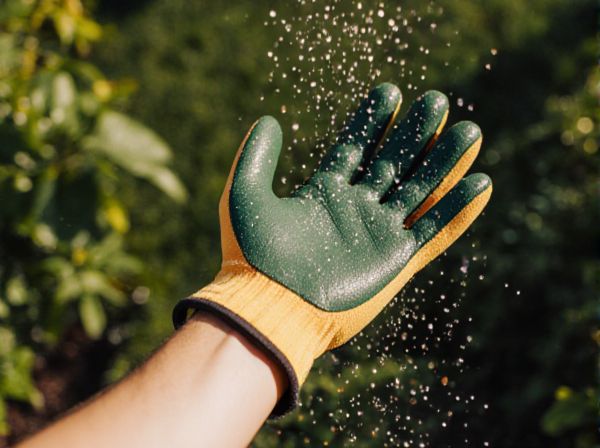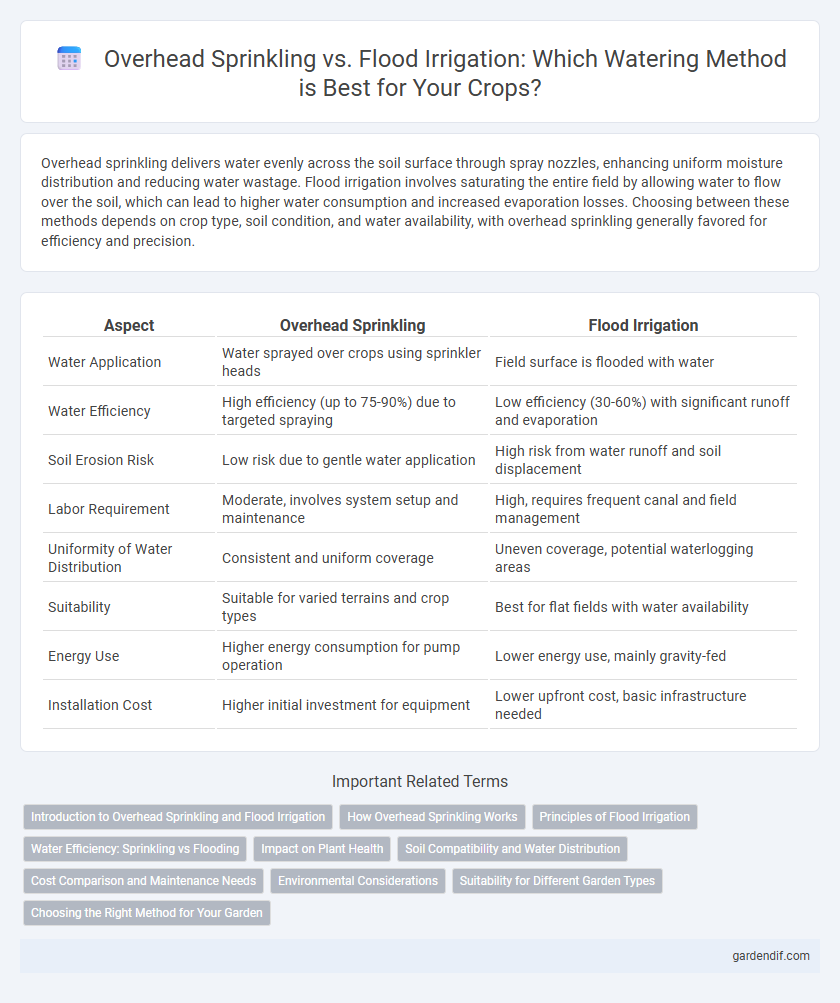
Overhead sprinkling vs Flood irrigation Illustration
Overhead sprinkling delivers water evenly across the soil surface through spray nozzles, enhancing uniform moisture distribution and reducing water wastage. Flood irrigation involves saturating the entire field by allowing water to flow over the soil, which can lead to higher water consumption and increased evaporation losses. Choosing between these methods depends on crop type, soil condition, and water availability, with overhead sprinkling generally favored for efficiency and precision.
Table of Comparison
| Aspect | Overhead Sprinkling | Flood Irrigation |
|---|---|---|
| Water Application | Water sprayed over crops using sprinkler heads | Field surface is flooded with water |
| Water Efficiency | High efficiency (up to 75-90%) due to targeted spraying | Low efficiency (30-60%) with significant runoff and evaporation |
| Soil Erosion Risk | Low risk due to gentle water application | High risk from water runoff and soil displacement |
| Labor Requirement | Moderate, involves system setup and maintenance | High, requires frequent canal and field management |
| Uniformity of Water Distribution | Consistent and uniform coverage | Uneven coverage, potential waterlogging areas |
| Suitability | Suitable for varied terrains and crop types | Best for flat fields with water availability |
| Energy Use | Higher energy consumption for pump operation | Lower energy use, mainly gravity-fed |
| Installation Cost | Higher initial investment for equipment | Lower upfront cost, basic infrastructure needed |
Introduction to Overhead Sprinkling and Flood Irrigation
Overhead sprinkling systems distribute water through elevated sprinklers, mimicking natural rainfall to cover large areas quickly and uniformly. Flood irrigation involves channeling water directly over soil surfaces, allowing it to seep and saturate crops, which is suitable for flat terrains with abundant water supply. Understanding the mechanics, efficiency, and suitability of these methods is essential for optimizing water use in agricultural irrigation.
How Overhead Sprinkling Works
Overhead sprinkling systems distribute water through a network of elevated pipes and sprinkler heads, simulating natural rainfall by spraying water evenly over the crop canopy. This method enables precise control over water application rates and timing, reducing water wastage and minimizing soil erosion compared to flood irrigation. The technology often incorporates timers and sensors to optimize irrigation schedules based on weather conditions and soil moisture levels.
Principles of Flood Irrigation
Flood irrigation operates by distributing water evenly over the soil surface, allowing it to infiltrate gradually and replenish soil moisture. This method relies on gravity to move water across flat or gently sloped fields, ensuring thorough saturation primarily in crops with deep root systems. Proper land leveling and controlled water flow are essential principles to maximize water efficiency and reduce runoff or soil erosion during flood irrigation.
Water Efficiency: Sprinkling vs Flooding
Overhead sprinkling delivers water more uniformly across crops, minimizing runoff and deep percolation losses, which boosts water efficiency compared to flood irrigation. Flood irrigation often leads to uneven water distribution, causing higher evaporation and infiltration beyond the root zone, resulting in substantial water waste. Modern sprinkler systems can optimize water application timing and pressure, enhancing conservation of water resources in agricultural practices.
Impact on Plant Health
Overhead sprinkling provides uniform water distribution that helps prevent dry spots and supports consistent plant growth, yet it can increase the risk of foliar diseases due to prolonged leaf wetness. Flood irrigation allows deep soil saturation and encourages root development but often leads to waterlogging and soil compaction, which can stress plants and reduce oxygen availability. Selecting the irrigation method depends on balancing water efficiency with plant health needs to optimize growth and minimize disease occurrence.
Soil Compatibility and Water Distribution
Overhead sprinkling provides uniform water distribution and is compatible with various soil types, especially sandy and loamy soils, reducing surface runoff and erosion risk. Flood irrigation is better suited for clayey soils with high water retention but often leads to uneven water distribution and potential waterlogging. Selecting the appropriate irrigation method depends on soil texture, permeability, and crop water requirements for optimal soil moisture management.
Cost Comparison and Maintenance Needs
Overhead sprinkling systems generally have higher initial installation costs due to equipment and setup complexity, while flood irrigation requires lower upfront investment but may incur higher water usage expenses over time. Maintenance for overhead sprinklers involves regular inspection and repair of nozzles, pumps, and pipes to ensure even water distribution, whereas flood irrigation demands ongoing management of field leveling and channel clearing to prevent waterlogging and inefficiency. Choosing between these irrigation methods depends on balancing equipment costs with long-term water use efficiency and labor requirements.
Environmental Considerations
Overhead sprinkling reduces water runoff and soil erosion by delivering controlled water amounts directly to the plant canopy, promoting efficient water use and minimizing nutrient leaching compared to flood irrigation. Flood irrigation often leads to excessive water consumption, increased evaporation losses, and potential groundwater contamination from fertilizer runoff. Implementing overhead sprinkling systems supports sustainable water management and conserves local water resources, especially in regions facing water scarcity.
Suitability for Different Garden Types
Overhead sprinkling suits small to medium-sized gardens and lawns, providing even water distribution and reducing water waste through targeted spray patterns. Flood irrigation is more effective for large, flat areas like vegetable gardens and orchards, where slow, deep soaking promotes root growth and minimizes erosion. Selecting the appropriate method depends on garden size, plant types, and soil drainage characteristics.
Choosing the Right Method for Your Garden
Choosing the right watering method for your garden depends on factors such as plant types, soil composition, and water availability. Overhead sprinkling provides uniform coverage and is ideal for lawns and delicate plants, while flood irrigation is more suitable for crops requiring deep, consistent moisture and can be more water-efficient on permeable soils. Assessing your garden's specific needs and irrigation goals helps optimize water use and promotes healthier plant growth.
Overhead sprinkling vs Flood irrigation Infographic

 gardendif.com
gardendif.com